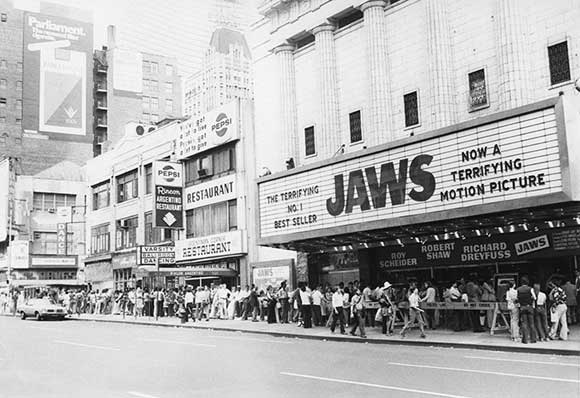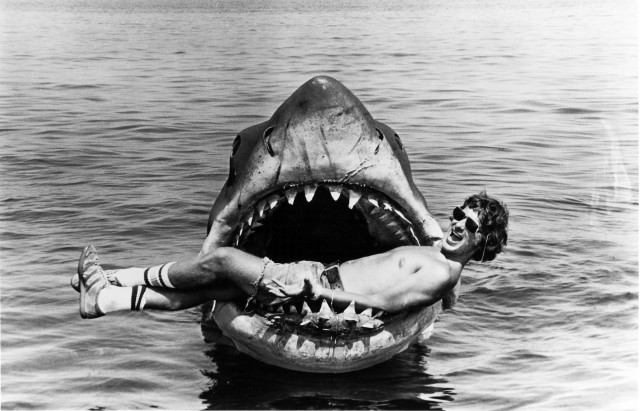Steven Spielberg’s Jaws turns 40 on the 20th of June this year. 40. Forty years old. To put it into perspective, that is almost double the period since Delhi became a National Capital Territory and it is four times the mental age of most of Adam Sandler’s films. And yet, if we go by the scales of modern-day geriatrics, it might only qualify as a ‘middle-aged’ film. But again, age is relative. For my grandparents, an ‘oldie’ film might be one in black-and-white. For others, an ‘old’ film may be anything on the older side of the 1990’s. However relative that perspective is, there remains an almost unanimous acknowledgment of some films as ‘classics.’ The Godfather (Duology) is one, Lawrence of Arabia is another and so are others like 12 Angry Men, Vertigo and The Sound of Music. And then there is the other….

“We’re gonna need a bigger boat.”
Chief Martin Brody’s immortal lines and no one could agree more. Based on the novel of the same name, Jaws is the story of a twenty, twenty-five foot (Official figures vary) shark that terrorizes the small, tourist island of Amity in the Unites States. Now, films revolving around Man vs. Nature struggles aren’t particularly new today and, neither were they really original in 1975. And yet, Jaws would not only tip the suspense-thriller and horror genre on its head but go on to influence cinema, in America and abroad long after its release. As Sholay’s Veeru once said, ‘Iss story mein emotion hain, drama hain, tragedy hain.’
The film opens on an equally, if not more terrifying note than that sounds with kids, not much older than most of us are, skinny-dipping in the Atlantic Ocean. Obviously it doesn’t end well but, the effectiveness of that opening scene alone sets the tone for the rest of this terrific film. Using the handheld that predated the one made famous by Greengrass, Spielberg keeps the camera at or just below-sea level and gives a mercilessly quick scale of the attack. However, what set Jaws apart from its contemporaries and influenced the scores of films to come later was its antagonist, the Great White Shark.
Most suspense/thriller/horror movies today rely sadly on blood and gore to make the audience squirm in their seats. The ‘scare’ as they like to believe is short, quick and diffuse. Jaws however, was almost Hitchcockian in the way it dealt with tension and drama on screen. The ‘false scare’ as Hitchcock called it and, Spielberg later perfected, was meant to sweat the audience raw in fear, until it broke in resolution or mayhem, rendering the tension, the anticipation of it more frightening than the horror itself.
Elevated by John Williams’ Academy-Award winning score that accelerated with every Da Dun…. Da Dun.., the real horror of Spielberg’s film lay in the anticipation of the primal enemy and the fear of the unknown. And it are the almost frivolous things that create the most tension in this film, whether it a floating barrel or a broken dock or even as naïve as tattered clothes. Tension so discomforting, that it literally squirms the audience out of their seat. And to think, Spielberg achieved all that despite how clumsy, laughable and malfunctioning the mechanical shark was in 1975.
Jaws remains until this day, one of the most influential films in history. In fact, almost every Nature-gone-rogue film today like Piranha, Sharknado etc. and even horror films like The Conjuring and The Poltergeist borrow heavily. But, the impact Jaws has had transcends its own genre. In fact put simply, Jaws was revolutionary. Not only with regard to the cultural appeal of its elusively dangerous antagonist (Who, as a poll conducted by Washington Post says, has a better shot at the White House than any of the current Presidential candidates), but also with regard to its marketing and distribution strategies.
Jaws, despite the fact that the film was almost three times over the budget and finished over 100 days behind schedule went on to be the highest-grossing film of all-time until Star Wars released years later. However, that is not the reason why the film industry still remembers it. Jaws was Hollywood’s first bonafide summer blockbuster, a season which hardly saw any major releases, considering that it coincided with baseball season (Much like the drought during the IPL season every year). It was with this film in the sunny months of June 1975 that the trend of high-concept, ambitious and blockbuster summer releases become a practice and almost every major studio and film today like the Harry Potter franchise, Transformers, The Avengers, will attest to that fact.

Secondly, contrary to popular practice, Universal Studios was the first to distribute and release a film on such a massive scale, simultaneously. Ordinarily, films were released in one state first and then allowed to release in other places, selling tickets by way of word-of-mouth. Jaws changed all that with a massive nationwide release of over 475 screens and the rest, as they say is history with this practice still the norm today. Jaws was also the first film of its kind to use the emerging medium of Television to its advantage, and use it to bring people to watch the film. Advertisement and TV-spots may be the norm today but, it all began with a 20-foot Great White in 1975.
IMDb states the date of Jaws’ India release to be on December 26, 1975. I highly doubt the truth of that, or that many did actually get to see it in cinema screens. And perhaps yes, I get why a film like Jaws did not have an impact on the Indian film industry beyond its commercial and marketing gimmicks as it did on Hollywood. After all, I don’t recall many man-eating sharks living off the coast of our country. And yet since the day I first saw it and until today, when I watch it again on its 40th anniversary, it is as tense and exciting as the first time. And although I may not be afraid of going into the water now, I do make sure that I don’t go in without people I can’t overrun (Swim, rather). That was the genius of Spielberg, a man who made an ugly-looking contraption the immortal villain of one of the best thrillers ever made. And despite the many great films he would make such as Schindler’s List, Saving Private Ryan and Jurassic Park, they’ll never be as memorable as the sight of a girl screaming into the breaking dawn, as the ocean swallows her.




































